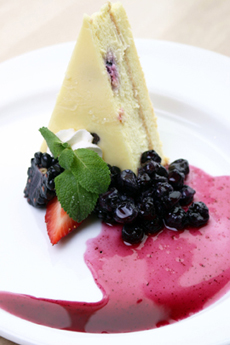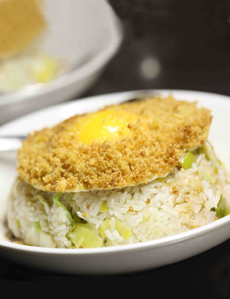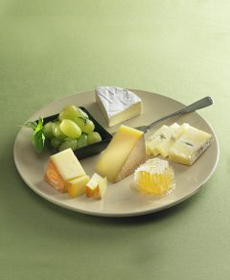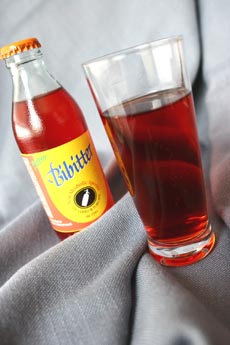
A slice of blueberry cheesecake with blueberry purée. Photo © Rohit Seth | Fotolia. |
|
We asked Chef Johnny Gnall to discourse on purées—an easy way to add elegance to sweet or savory dishes.
A purée is a terrific way to showcase a fruit or vegetable in a different way. This versatile sauce allows you to add a fruit or vegetable seamlessly into another dish, layering flavor in a behind-the-scenes kind of way. It also makes an impressive and colorful swoosh on plates: one that impresses visually and in flavor (see photo below).
If you watch TV shows like “Top Chef,” you may have heard the chefs and judges referring to “coulis” (coo-LEE). The difference between a purée and a coulis is refinement: to make coulis, the purée is strained.
To do it, simply use a rubber spatula to push the purée through a mesh strainer or chinoise (SHEEN-wahz), which removes the seeds and skin. Voilà: Your purée is now a coulis!
After straining, a coulis displays a truly lovely sheen and smooth texture—one very well suited to a fancy dinner party.
HOW TO CREATE A PERFECT PURÉE
Creating a terrific purée is not a matter of simply puréeing a fruit or vegetable in the food processor. Here’s a basic step-by-step process to create a purée, addressing all the speed bumps.
|
|
Use a blender, not a food processor. Sure, a food processor can work, but blenders are ideal for a couple of reasons (many professional chefs use the Vitamix brand). First, there is less space inside a blender than a food processor, so the ingredients will get mashed up faster and better. Additionally, blenders are shaped and structured in a way that facilitates a vortex, that channel of air you often see appear in the center of your spinning food or liquid that looks like a tornado or a whirlpool. This vortex sucks the ingredients downward towards the blade, which is where the puréeing takes place. A hand blender can also work with purées, but will usually take much longer.
Scrape and stir as you go. Every so often it’s good to move things around in the bender with a spoon or spatula. Things will get lodged if your product is a more challenging one (such as dried fruit); giving everything a few stirs will help you determine how well everything has puréed down and what the consistency of your purée is like. Make sure you unplug the blender before you stick a utensil in it!
Season as you go. Just as with any cooking project, the more often you taste and season your purée, the better the final outcome will be. Remember that a purée is like any other dish: It should have a balance of taste, from sweet to salty to tart (acidity) and everything in between. Sherry vinegar is a great acid as it has a bit of its own sweetness in addition to a tangy punch. If you want minimal acidity, rice wine vinegar is also a good choice. Balsamic vinegar works, too, but adds a stronger stamp to the overall flavor.
|
|
Consistency is extremely important to a good purée. There is no right or wrong consistency, but depending on what application you have in mind, adjust the purée’s thickness accordingly. If you want to spread it across a plate—under a piece of meat, for example—make the purée on the thicker side. If you want to be able to drizzle it over food, go for something thinner. Liquid, quite naturally, is a great way to thin things out. Just use a liquid whose flavors work in the purée (don’t use chicken stock in a fruit purée). A general rule of thumb is to use fruit juice for sweet purées and stock for savory ones, but feel free to go wild: wine or liquor, milk, even something like tomato soup. As long as the flavors make sense, go for it.
Sheen matters, too. “Nothing says ‘I’m sexy’ like a shiny, velvety-looking purée,” says Chef Gnall. The way to achieve the ideal is to drizzle in a bit of oil at the end of the process. Drizzling in some oil very slowly, as the purée spins. Watch it like a hawk: As soon as you see the glossy sheen, stop adding oil. If you add too much of it, your purée will taste like the oil you’re using to shine it up. Olive oil works fine, and so do flavored or neutral oils. As with the liquid, just make sure things match the flavor profile of whatever it is you’re puréeing.
|
|

Pastry chef Gael Gand uses both a cherry and a lemon coulis to grace her cheesecake. Photo courtesy Tru Restaurant | Chicago.
|
There’s nothing like a puree to add glamour and pizzazz. If you develop a favorite recipe, please share it with us.
Start with some liquid in addition to your fruit or vegetable. Often, and for a variety of reasons, a certain item will not want to purée: It will just sit at the bottom of the blender while the blade spins. By adding some liquid, a bit at a time, you can get things moving quickly. Your choice of liquid is up to you, but consider water or stock, depending on what you are puréeing. Avoid adding any oil early on: While water or stock will help you on your way, oil often just slicks things up and can actually prevent the purée process.
Add your product bit by bit. This rings especially true the more dense, sticky, or otherwise ornery your product gets. “To make a date purée, for example,” says Chef Gnall, “I begin with hot water and two or three pitted dates. Once I get a small amount of purée that is nice and loose, I add dates one at a time. Dates, in particular, are a challenge because of their sticky flesh. If you were to dump 20 dates into the blender and pressed Start, you’d overheat the motor (which can happen if you tax it for too long) before you actually accomplished anything.”
|
|




